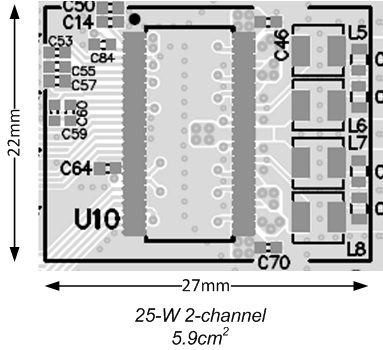JAJSCS6 December 2016 TAS6422-Q1
PRODUCTION DATA.
- 1 特長
- 2 アプリケーション
- 3 概要
- 4 改訂履歴
- 5 Device Comparison Table
- 6 Pin Configuration and Functions
- 7 Specifications
- 8 Parameter measurement Information
-
9 Detailed description
- 9.1 Overview
- 9.2 Functional Block Diagram
- 9.3
Feature Description
- 9.3.1 Serial Audio Port
- 9.3.2 High-Pass Filter
- 9.3.3 Volume Control and Gain
- 9.3.4 High-Frequency Pulse-Width Modulator (PWM)
- 9.3.5 Gate Drive
- 9.3.6 Power FETs
- 9.3.7 Load Diagnostics
- 9.3.8
Protection and Monitoring
- 9.3.8.1 Overcurrent Limit (ILIMIT)
- 9.3.8.2 Overcurrent Shutdown (ISD)
- 9.3.8.3 DC Detect
- 9.3.8.4 Clip Detect
- 9.3.8.5 Global Overtemperature Warning (OTW), Overtemperature Shutdown (OTSD)
- 9.3.8.6 Channel Overtemperature Warning [OTW(i)] and Shutdown [OTSD(i)]
- 9.3.8.7 Undervoltage (UV) and Power-On-Reset (POR)
- 9.3.8.8 Overvoltage (OV) and Load Dump
- 9.3.9 Power Supply
- 9.3.10 Hardware Control Pins
- 9.4 Device Functional Modes
- 9.5 Programming
- 9.6
Register Maps
- 9.6.1 Mode Control Register (address = 0x00) [default = 0x00]
- 9.6.2 Miscellaneous Control 1 Register (address = 0x01) [default = 0x32]
- 9.6.3 Miscellaneous Control 2 Register (address = 0x02) [default = 0x62]
- 9.6.4 SAP Control (Serial Audio-Port Control) Register (address = 0x03) [default = 0x04]
- 9.6.5 Channel State Control Register (address = 0x04) [default = 0x55]
- 9.6.6 Channel 1 Through 2 Volume Control Registers (address = 0x05-0x06) [default = 0xCF]
- 9.6.7 DC Load Diagnostic Control 1 Register (address = 0x09) [default = 0x00]
- 9.6.8 DC Load Diagnostic Control 2 Register (address = 0x0A) [default = 0x11]
- 9.6.9 DC Load Diagnostic Report 1 Register (address = 0x0C) [default = 0x00]
- 9.6.10 DC Load Diagnostics Report 3—Line Output—Register (address = 0x0E) [default = 0x00]
- 9.6.11 Channel State Reporting Register (address = 0x0F) [default = 0x55]
- 9.6.12 Channel Faults (Overcurrent, DC Detection) Register (address = 0x10) [default = 0x00]
- 9.6.13 Global Faults 1 Register (address = 0x11) [default = 0x00]
- 9.6.14 Global Faults 2 Register (address = 0x12) [default = 0x00]
- 9.6.15 Warnings Register (address = 0x13) [default = 0x20]
- 9.6.16 Pin Control Register (address = 0x14) [default = 0x00]
- 9.6.17 AC Load Diagnostic Control 1 Register (address = 0x15) [default = 0x00]
- 9.6.18 AC Load Diagnostic Control 2 Register (address = 0x16) [default = 0x00]
- 9.6.19 AC Load Diagnostic Impedance Report Ch1 through CH2 Registers (address = 0x17-0x18) [default = 0x00]
- 9.6.20 AC Load Diagnostic Phase Report High Register (address = 0x1B) [default = 0x00]
- 9.6.21 AC Load Diagnostic Phase Report Low Register (address = 0x1C) [default = 0x00]
- 9.6.22 AC Load Diagnostic STI Report High Register (address = 0x1D) [default = 0x00]
- 9.6.23 AC Load Diagnostic STI Report Low Register (address = 0x1E) [default = 0x00]
- 9.6.24 Miscellaneous Control 3 Register (address = 0x21) [default = 0x00]
- 9.6.25 Clip Control Register (address = 0x22) [default = 0x01]
- 9.6.26 Clip Window Register (address = 0x23) [default = 0x14]
- 9.6.27 Clip Warning Register (address = 0x24) [default = 0x00]
- 9.6.28 ILIMIT Status Register (address = 0x25) [default = 0x00]
- 9.6.29 Miscellaneous Control 4 Register (address = 0x26) [default = 0x40]
- 10Application and Implementation
- 11Power Supply Recommendations
- 12Layout
- 13デバイスおよびドキュメントのサポート
- 14メカニカル、パッケージ、および注文情報
1 特長
- 車載アプリケーションに対応
- オーディオ入力
- 2チャネルのI2Sまたは4/8チャネルのTDM入力
- 入力サンプル・レート: 44.1kHz、48kHz、96kHz
- 入力フォーマット: 16ビットから32ビットのI2SおよびTDM
- オーディオ出力
- 2チャネルのBTL (Bridge-Tied Load)、並列BTL (PBTL)のオプションあり
- 最大2.1MHzの出力スイッチング周波数
- 75W、10% THD (4Ω、25V)
- 45W、10% THD (2Ω、14.4V)
- 150W、10% THD (2Ω、25V PBTL)
- 14.4V、4Ω負荷でのオーディオ性能
- 1WでTHD+N < 0.03%
- 出力ノイズ: 42µVRMS
- クロストーク: -90dB
- 負荷診断
- 出力開路および負荷短絡
- 出力からバッテリまたはグランドへの短絡
- 最大6kΩのライン出力検出
- 内部クロックなしで動作
- AC診断によるツイータ検出
- 保護
- 出力電流制限
- 出力短絡保護
- 40Vの負荷ダンプ
- グランド/電源オープンへの耐性
- DCオフセット
- 過熱
- 低電圧および過電圧
- 一般的な動作
- EVMはCISPR25-L5 EMC仕様に合格
- 4.5V~26.4Vの電源電圧
- 4つのアドレス・オプションを持つI2C制御
- クリップ検出およびサーマル警告
2 アプリケーション
- 車載用ヘッド・ユニット
- 車載用外部アンプ・モジュール
3 概要
TAS6422-Q1デバイスは、2チャネルのデジタル入力Class-Dオーディオ・アンプで、車載用ヘッド・ユニットや外部アンプ・モジュールで使用するよう設計されています。このデバイスには2つのチャネルがあり、14.4V電源から4Ω負荷へ10% THD+Nで27Wを、2Ω負荷へ10% THD+Nで45Wを、25V電源から4Ω負荷へ10% THD+Nで75Wを供給できます。Class-Dトポロジにより、従来のリニア・アンプ・ソリューションと比較して劇的に効率が向上しています。出力スイッチング周波数をAMバンドよりも高く設定すると、AMバンドの干渉を排除し、出力フィルタリングを減らしてコストを削減できます。また、AMバンドよりも低く設定すれば、効率を最適化できます。
4.5V~26.4Vの広い電源電圧範囲で動作するため、始動/停止アプリケーションにおけるオーディオのアーティファクト発生を最小限に抑えることができます。
このデバイスには、要求の厳しいOEMアプリケーションの分野で性能を発揮するため必要なすべての機能が搭載されています。デバイスには負荷診断機能が組み込まれており、出力の誤接続や、AC結合されたツイータを検出できるため、製造プロセスにおいてテスト時間を短縮するために役立ちます。
このデバイスは、56ピンのHSSOP PowerPAD™パッケージで、サーマル・パッドが上面に露出した形態で供給されます。
ピン互換の4チャネルのデバイスについては、TAS6424-Q1デバイスを参照してください。
製品情報(1)
| 型番 | パッケージ | 本体サイズ(公称) |
|---|---|---|
| TAS6422-Q1 | HSSOP (56) | 18.41mm×7.49mm |
- 利用可能なすべてのパッケージについては、このデータシートの末尾にある注文情報を参照してください。
PCB領域

4 改訂履歴
| 日付 | 改訂内容 | 注 |
|---|---|---|
| 2016年12月 | * | 初版 |